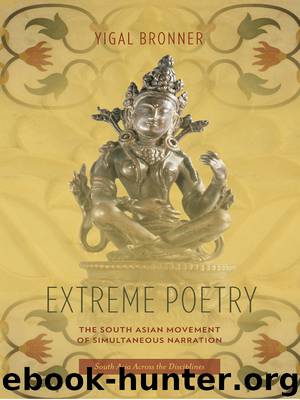Extreme Poetry by Yigal Bronner

Author:Yigal Bronner
Language: eng
Format: epub
Tags: Literary Criticism/Asian/General
Publisher: Columbia University Press
Published: 2012-02-28T16:00:00+00:00
6.6 DOUBLE-BODIED POET, DOUBLE-BODIED POEM: RAVICANDRA’S READING OF AMARU
Commentators in the sixteenth, seventeenth, and eighteenth centuries applied the śleṣa tool kit profusely to an impressive variety of genres, including verse (e.g., Kālidāsa’s Meghadūta), prose (e.g., Subandhu’s Vāsavadattā), and the epic.86 Their innovative and sophisticated commentarial methods allowed them to read at least portions of all these works in light of the newest poetic fashions, in effect turning them into cutting-edge kāvyas. A colossal example of this trend, which comes complete with its poetic notion and explicit rationale, is found in a radical reinterpretation of one of the most celebrated works of the Sanskrit canon, the Amaruśataka.
Named after its putative author Amaru (or Amaruka), the Amaruśataka is a collection of roughly 100 vignettes of love. The poems depict set scenes such as the lovers’ playful quarrel, heartbreaking separations, and passionate unions. The characters are anonymous: he (nāyaka), she (nāyikā), her experienced friend (sakhī), and her go-between (dūtī). The Amaruśataka was extensively quoted in anthologies and also enjoyed a considerable amount of attention from a variety of intellectuals, including the prominent Kashmiri literary theorist Ānandavardhana (c. 850) and the authoritative thirteenth-century commentator Arjunavarmadeva. The former expressed the general admiration for Amaru by saying that even a single verse of his collection “may flow with a flavor of love (śṛṅgārarasa) equal to that of an entire volume.”87
But according to the commentator Ravicandra, who probably lived in the Bengal area and whose date is uncertain,88 each verse in Amaru’s collection also flows with the flavor of equanimity or peace (śāntarasa). In other words, what Ravicandra finds truly admirable in the Amaruśataka—the most salient and hitherto-unnoticed feature of the work—is its ability to evoke the two conflicting sentiments of passion and dispassion simultaneously. He states in the preface to his commentary:
Austere detachment versus
overindulgence in sex.
What a pair of opposites!
It takes a rare gift of a poet
to depict them both
in one strophe.89
Amaru’s real distinction is his ability to speak simultaneously of the ascetic and the erotic. Note that this kind of poetry has a long history in Sanskrit, beginning with occasional punned verses in the anthology ascribed to Bhartṛhari (seventh century) and culminating in full-fledged passion-dispassion collections, such as the Śṛṅgāravairāgyataraṅgiṇī by the thirteenth-century Jain poet Somaprabhācārya or the Rasikarañjanam of Rāmacandra (c. 1524).90 These works use śleṣa to examine the dialectic of eroticism and asceticism, and it is clear from Ravicandra’s comments that he views Amaru’s century of poems as belonging to this avant-garde genre.
To appreciate Ravicandra’s remarkable reinterpretation of Amaru, let us briefly consider how this text is read traditionally. Take, for example, the work’s introduction. The versions of the Amaruśataka, which otherwise vary considerably, all open with the same three benedictory verses. The first describes the playful sidelong glances of the Goddess and invokes their protection of readers. The second invokes Śiva’s fire-arrow: its flames are said to embrace the women of the Triple City (which Śiva destroyed) like a man who tries to appease his betrayed lover, clinging to her even as she is trying to brush him off.
Download
This site does not store any files on its server. We only index and link to content provided by other sites. Please contact the content providers to delete copyright contents if any and email us, we'll remove relevant links or contents immediately.
| Coloring Books for Grown-Ups | Humor |
| Movies | Performing Arts |
| Pop Culture | Puzzles & Games |
| Radio | Sheet Music & Scores |
| Television | Trivia & Fun Facts |
Spell It Out by David Crystal(36025)
Professional Troublemaker by Luvvie Ajayi Jones(29573)
We're Going to Need More Wine by Gabrielle Union(18953)
The Secret History by Donna Tartt(18815)
Cat's cradle by Kurt Vonnegut(15158)
The Goal (Off-Campus #4) by Elle Kennedy(13489)
The Social Justice Warrior Handbook by Lisa De Pasquale(12127)
The Break by Marian Keyes(9291)
Crazy Rich Asians by Kevin Kwan(9150)
The remains of the day by Kazuo Ishiguro(8794)
Thirteen Reasons Why by Jay Asher(8771)
Educated by Tara Westover(7920)
The handmaid's tale by Margaret Atwood(7664)
Giovanni's Room by James Baldwin(7165)
Win Bigly by Scott Adams(7079)
This Is How You Lose Her by Junot Diaz(6762)
The Rosie Project by Graeme Simsion(6164)
Six Wakes by Mur Lafferty(6119)
The Power of Now: A Guide to Spiritual Enlightenment by Eckhart Tolle(5586)
